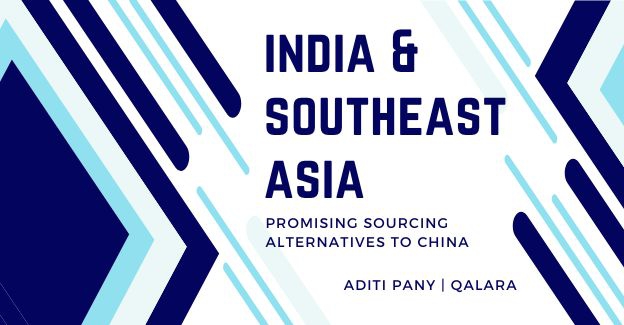Today, buyers can no longer depend on just one country for all their sourcing needs says Aditi Pany, CEO of Qalara.com. She offers detailed insights into the strong benefits of sourcing from this region and why it makes for a sound business decision.
The south and southeast regions of Asia comprising nearly 19 countries, including India, Indonesia, Vietnam and Thailand among others, have a rich history of production and trade going back thousands of years. In fact, historians believe that the world’s first long distance trade occurred between Mesopotamia and the Indus Valley (Indian subcontinent) in 3,000 BC, centered around textiles, spices, jewelry and artifacts.
While China has been the undisputed manufacturing epicenter for decades now, in recent times, export manufacturing in this part of the world has seen tremendous evolution and a renewed gusto. Today, Bangladesh, Vietnam and India are among the top five textile exporters in the world. India is the largest producer and exporter of spices in the world while Thailand and Indonesia are the top two exporters of rubber products, covering nearly 55% of all exports in this category worldwide.
This growth has been driven by a number of factors that will continue to strengthen the crucial role of this region in global trade in the coming decades. Here are some key levers that are increasingly making these countries viable sourcing options aside from China.
1. Rising Labor Costs in China
China’s wages have increased multifold since 2011, resulting in a minimum wage difference of up to 50% compared to countries such as Indonesia and parts of India. At the same time, labor policy reforms, productivity improvements due to better infrastructure and machinery, and the access to a huge workforce positions these countries as an attractive alternative.
2. Rapidly Evolving Manufacturing Support Ecosystems Powered by Digitization and Economic Development
The growing strength of domestic markets in these regions and the deep penetration of digitization in their economies has benefited the manufacturing ecosystem. Massive strides in payments, innovation and reach of domestic logistics and packaging as well as an improved digitally enabled visibility of the production floor have given rise to better services, lower investment costs and a digitally savvy manufacturer base. This in turn positively impacts the cost, quality competitiveness and transparency in these countries.
3. Lower Tariffs With Growing Free Trade Agreements
The countries in these regions have been actively and successfully negotiating free trade or preferential trade agreements with the western countries in the last few years. These have resulted in steadier and lower duties and tariffs, especially compared to China in recent times. For instance, Vietnam signed a comprehensive trade agreement with the European Union (EU) in 2020 while India and the EU have set up a high-level Trade & Technology Commission to strengthen ties.
4. Big Focus on Sustainable and Eco-Friendly Production
With their tropical geographical locations, these regions of Asia have been endowed with natural resources across a variety of materials including wood, bamboo, stone, marble, and metals such as copper and brass. The local artisans who possess centuries-old rich craftsmanship cleverly convert these natural materials into everyday objects incorporating modern design sensibilities. There is an incredible amount of product innovation using natural materials taking place in India, Vietnam and Indonesia. With an increasing awareness and demand for eco-friendly products, these regions will play a huge role in the move towards a sustainable global supply chain and consumption.
5. Low Minimums Enabling New Brands, Wider Selection and Less Waste
Two of the current big global retail trends are (a) the growing share of small and medium-sized brands in retail due to the democratization of digital distribution led by e-commerce platforms and (b) the growing importance of e-commerce as a key channel for sales.
Both of these trends require a global supply chain that is able to manufacture low minimums with quick turnarounds to support new brands and enable their breadth of selection online. Given the inherent labor-intensive nature of production in these countries, manufacturers are often willing and able to produce goods, including private labels, at lower minimums compared to China.
6. Bridging of the Information Asymmetry
In the past, China has been in the lucrative position of intimate access to product, pricing and trends because it has been the epicenter of manufacturing for the world’s plethora of global brands. However, in this new age of information, the pervasiveness of social media, digital commerce, the global gig economy and even digital trade fairs have given manufacturers in these countries easy access to insights on the latest trends, pricing, seasonal merchandising and much more. They are able to quickly adapt and put out exciting product ranges at the right prices and right time like never before. It’s a relatively better level playing field than ever before.
7. Growing Ease of Access to the Manufacturers and Suppliers, Digitally and Affordably
While Alibaba.com was the pioneer in cross border B2B e-commerce, today India and the Southeast Asian regions have a growing share of their own digital B2B marketplaces and platforms. These platforms are curating and consolidating vetted supplier bases, while plugging the gaps to drive efficiencies and reliability in quality, global logistics, global payments and more, making it easy for businesses around the world to discover and source from them remotely, conveniently and affordable.
While there is still a long way for this region to catch up with China in terms of infrastructure, pervasiveness of advanced machinery, global supply chain ecosystem and the trade knowledge, India and the southeast Asian countries have unique advantages that make a compelling argument for big and small retailers, importers and brands to strongly consider devising sourcing strategies beyond China to give their businesses a competitive edge.






